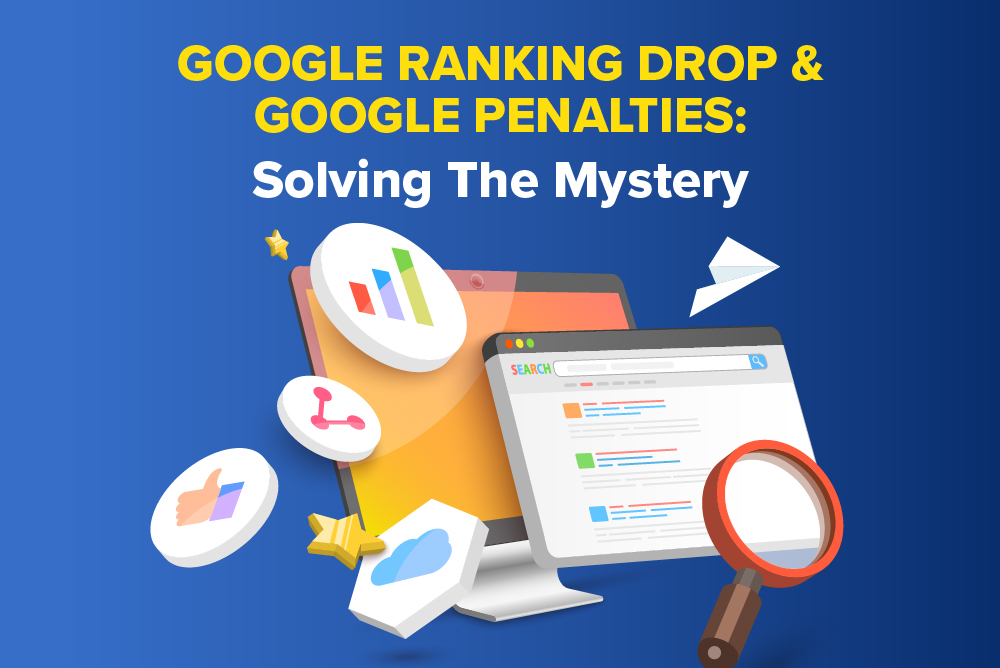A Google ranking penalty is a punitive action taken by Google against websites that violate its Webmaster Guidelines, leading to a drop in the website’s search engine results page (SERP) rankings. The impact of a penalty can range from a slight Google ranking drop for some keywords to complete removal from search results, significantly reducing organic traffic.
This penalty can be automatic, due to algorithm updates, or manual, where a Google employee directly penalises a site. Common reasons for receiving a penalty include engaging in black-hat SEO practices like keyword stuffing, cloaking, creating spammy or low-quality backlinks, and publishing duplicate or thin content. Recovering from a Google penalty involves identifying the cause, rectifying the offending issues, and submitting a reconsideration request to Google for manual penalties.
Suspect A Google Penalty Has Hit Your Website?
Ever experienced that heart-sinking moment when you notice your website’s rankings on Google have suddenly plummeted? If you’re an SEO professional, marketer, or business owner, you know that fear and anxiety all too well. You’re left scrambling, trying to figure out why your hard-earned rankings are nosediving.
Let me tell you, in the ever-evolving world of SEO, this is more common than you might think. Ranking drops can be triggered by a multitude of factors, ranging from changes you’ve made on your site to those elusive Google algorithm updates. Whether it’s an internal misstep or an external shake-up, understanding these ranking shifts is key to navigating the choppy waters of SEO.
Insights from My 6-Year Journey With Google Rank Drops
With over six years in the SEO field and having worked on more than 800 websites, I’ve seen my fair share of Google ranking drops. These experiences, ranging from internal website issues and competitive shifts to algorithm updates, have been invaluable. Each instance has been a learning opportunity, helping me to quickly diagnose the causes, strategize effective recovery plans, and often improve rankings beyond their original positions.
I’ve shared these insights on platforms like LinkedIn and the Moz community, aiming to help others navigate the complexities of SEO and ranking fluctuations with the knowledge I’ve gained from these challenges. Bringing this wealth of experience and learnings to First Page’s blog, I’m eager to share these insights more broadly, helping you, the reader, understand and effectively address ranking drops. Let’s dive into the causes, diagnostic methods, and recovery strategies that can turn these challenges into opportunities for growth.
Analysing Google Ranking Drops: Identifying Causes and Planning Recovery
The first step in addressing Google ranking drops is to analyze how the rankings have shifted. Here are some questions to ask yourself:
- Magnitude of Rank Drop: Is it a minor drop (less than 5 positions), moderate (5 to 10 positions), significant (20 or more positions), or a complete disappearance from SERP?
- Affected Pages: Are all pages affected, or just one or two?
- Clusters/Topics Impacted: Which specific clusters or topics are experiencing the drop?
- Nature of the Drop: Was the drop sudden or gradual over time?
- Google Algorithm Changes: Is there an ongoing Google algorithm update?
- Changes in SERP: Are there significant changes on the new Page 1 SERP?
- Competitors’ Performance: How are your main competitors faring in rankings?
- Keyword Ranking History: How long have your keywords been ranking previously?
- Unusual Site Activity: Are there any strange pages being created on your site without your knowledge?
The following table categorises different types of ranking drops, their likely causes, and the recommended actions to address them.
| Ranking Drop Scenario | Possible Cause | Action to Consider |
| Minor slips in ranking | Normal fluctuation | Often recover without intervention |
| Continuous slip over a quarter | Competition outperforming SEO efforts | Review and adjust SEO strategy |
| Specific pages’ rankings disappearing | Internal issues (e.g., no-index tag, disallow command) | Check for technical errors or changes on the SERP |
| Significant site-wide drop | Manual or algorithm penalty | Identify and rectify issues (more details in this blog) |
With this broad guide in mind, let us now dive deeper into specific issues.
Google March 2024 Spam Update
The Google 2024 March spam update has led to a strict crackdown on low-quality sites, with penalties, including manual actions, being applied with unprecedented speed. Even websites that had previously navigated past updates unscathed are now grappling with the consequences of Google’s stringent new criteria. I’ve observed some crucial strategies that could help us navigate these changes. Here’s a detailed look at my insights:
- The Double-Edged Sword of Guest Posting: I urge caution with acquiring backlinks from sites that accept guest posts, especially those that also host generic, low-value content. Such platforms risk penalisation, which could devalue your links. It’s the quality and originality of the host site’s content that matters, not just the piece you contributed.
- Strategic Backlink Acquisition: Moving away from traditional backlink strategies, I recommend partnering with websites offering products or services. These sites naturally update their content to reflect their unique selling points and brand values, making them more resilient against Google’s quality checks.
- The Disavow Experiment: Given the fallout from the spam update, I’m experimenting with mass disavowing links from deindexed sites to see its effect on site health. This might offer a way to mitigate the indirect impacts of the update on our sites.
- Niche Focused Content Strategy: To withstand the update, it’s crucial to keep your website focused on a specific niche. Spreading your content topics too thin can dilute your site’s authority on any subject, leaving it vulnerable to Google’s crackdown on non-expert content.
- Monitoring Google Search Console (GSC): Given the inconsistency in Google’s communication about manual actions, I highlight the importance of regularly checking GSC for any penalties. We cannot rely solely on email notifications, as they may not always be sent.
- The False Security of DR and Traffic: The penalization of high Domain Rating (DR) and traffic sites demonstrates that these metrics alone do not safeguard against Google’s scrutiny. The focus is on the unique value and niche relevancy of the content, debunking the myth that high metrics guarantee credibility.
- The Increasing Difficulty of Proving Originality: I’ve noted the growing challenge in convincing Google of content originality and user experience quality. Reducing the number of guest post authors might be wise, as there seems to be a correlation between a high number of contributors and site penalties.
- Avoiding the AI Content Pitfall: Publishing a large number of articles in a short period is a clear indicator of AI-generated content. I advise against this practice and suggest a more deliberate approach to content creation.
Previous Google Algorithm Changes and Their Impact on Rankings
Google algorithm updates, which happen periodically, can significantly affect your site’s rankings by altering the importance of ranking factors, introducing new signals, modifying existing ones, or targeting specific practices like spammy links. Let’s delve into how these changes might influence your website’s performance in search results.
Ranking Factors Weightage Change
Core updates often shift the weightage of existing ranking factors. This can lead to significant fluctuations in rankings as certain aspects of websites are valued differently.
To adapt to changes in ranking factor weightage due to Google’s core updates, you should first review the update details, often available in Google’s algorithm update notes, which can be found on Google’s Search Central Blog. Then, analyze your website for any patterns that align with the update’s focus.
Similarly, observe if your competitors are experiencing parallel effects. It’s important to note, as Google’s John Mueller has stated, that changes made in response to an update may not reflect in your rankings until the next core update rolls out. This requires patience and continuous monitoring of your site’s performance and alignment with Google’s guidelines.
Introduction of New Ranking Signals
Google regularly updates its algorithm, introducing new ranking signals that significantly impact SEO strategies. Here are some notable examples:
April 2021 – Product Reviews Update
Details: This update was designed to reward in-depth, research-based product reviews over superficial content.
Webmaster Action: Webmasters needed to focus on creating detailed, well-researched product reviews.
February 2021 – Passage Ranking
Details: Google began considering individual passages from pages as an additional ranking factor, enhancing the ability to find specific information on a page.
Webmaster Action: Ensuring clarity and relevance in specific sections of content became crucial.
January 2020 – Featured Snippet Deduplication
Details: With this update, pages appearing in a featured snippet position would no longer be duplicated in regular Page 1 organic listings.
Webmaster Action: Optimization for featured snippets became more important for achieving prominent visibility.
December 2019 – BERT (Worldwide)
Details: The rollout of the BERT AI model worldwide aimed to better understand natural language in search queries.
Webmaster Action: Creating content that addresses queries in a natural, conversational manner was advised.
These updates reflect Google’s ongoing efforts to improve user experience and the accuracy of search results, necessitating continual adaptation and optimization by webmasters and SEO professionals.
Changes in Existing Requirements/Signals
Some Google updates don’t introduce entirely new concepts but rather enhance the significance of existing signals. A perfect example of this is the Core Web Vitals (CWV). CWV metrics, which measure a website’s performance in terms of loading speed, interactivity, and visual stability, were always a part of user experience measurements. However, they were officially recognized as ranking factors later on. This change highlights the importance of keeping abreast with SEO developments through reliable sources like SEO Roundtable.
Similarly, reviews have always been a significant factor in SEO, but with Google’s Review Update, there was a specific emphasis on first-hand reviews. This update prioritized reviews that demonstrated direct experience with the product or service, making authenticity and personal experience more crucial than ever. Key points of this update included the authenticity of the review, the uniqueness of the content, and the reviewer’s expertise and depth of knowledge about the product.
In response to these updates, it’s essential for webmasters and SEO professionals to consider what Google is emphasizing. Aligning your SEO efforts with these changes means not just adhering to the technical aspects, but also understanding the underlying intent – improving user experience and authenticity in the case of CWV and reviews, respectively. Keeping an eye on these trends and adapting accordingly can significantly boost your website’s performance in search rankings.
Continuous Spam Link Updates
Google frequently rolls out updates targeting spammy links, maintaining the integrity and relevance of search results. These updates are part of Google’s ongoing efforts to penalize websites with unnatural link profiles while rewarding those with authentic, high-quality backlinks.
The purpose of these spam link updates is to deter black-hat SEO practices, specifically the manipulation of search rankings through artificial or low-quality links. Google aims to ensure that the links contributing to a website’s ranking are genuine endorsements, reflecting the website’s actual relevance and authority.
As a webmaster or SEO professional, it’s crucial to regularly audit your website’s link profile. Tools like Ahrefs or SEMRush are invaluable for this purpose. They allow you to analyze your backlinks and identify any that seem suspicious or low-quality.
If you find problematic links, you can use Google’s Disavow Tool to formally distance your site from these links. This tool tells Google not to consider certain backlinks when assessing your site, which can be crucial in safeguarding your site’s reputation and ranking following a spam link update.
It’s important to note that the effects of using the Disavow Tool can vary significantly. In some cases, the impact is immediate, while in others, it might take months to manifest. This variation highlights the importance of careful and strategic use of the tool.
Internal Website Signals Affecting Google Indexing
Certain internal website configurations can inadvertently signal Google not to index a page or the entire website. Understanding and rectifying these issues is key to restoring your site’s visibility in search results.
- No Index Tag: If applied to pages, this tag directly instructs search engines not to index them.
- Disallow Command in Robots.txt: This command can prevent search engines from crawling specific pages or sections of your website.
- Canonical Tag Issues: A canonical tag pointing to another page can lead Google to prioritize the wrong page for indexing.
- Temporary Removal in Google Search Console (GSC): Pages added to the GSC’s temporary removal tool will be excluded from search results for the duration specified.
In these cases, you can refer to Google Search Console as it reports such statuses. Subsequently, you can remove the command or tag to reverse the issue. Addressing these issues involves reviewing and modifying your site’s internal settings to ensure Google can appropriately crawl and index your pages.
JavaScript Issues Leading to Ranking Drops
JavaScript can enhance user experience but also pose challenges for Googlebot’s crawling and indexing.
JavaScript Internal Links
When crucial internal links are in JavaScript, Googlebot may struggle to crawl them, affecting the site’s internal link structure and SEO. In this case, I would recommended avoiding the use of javascript links entirely as Google has repeatedly emphasised that they cannot crawl such links.
JavaScript for Rendering Content
Essential content rendered through JavaScript might not be indexed effectively if Googlebot faces difficulties in processing it. For content rendering, I recommend employing Server-Side Rendering (SSR) or similar techniques to ensure Googlebot can access and index your content efficiently.
Blocking JavaScript Files
Disallowing JavaScript files in robots.txt or conflicting codes can prevent Googlebot from rendering and understanding your page correctly. If this is the case, simply remove the command or modify it in your robots.txt file.
Negative SEO Attacks
Negative SEO attacks can severely harm a website’s ranking and reputation. Let’s explore the two common forms of these attacks and the appropriate response strategies.
Spammy Link Building Attacks
Scenario: A sudden influx of poor-quality and spammy links pointing to your website. These links often originate from malicious or irrelevant sites, possibly already penalized by Google. The anchor texts might include irrelevant or adult terms, or money-related keywords, falsely suggesting black-hat SEO tactics.
Discovery: Use third party link audit tools such as Ahrefs or Semrush. Alternatively, GSC’s link report will show new links to your website, which might reveal suspicious looking domains.
Response: Conduct a thorough audit of your link profile. Use the Disavow Tool to remove these harmful links. Ideally, try to get these links removed directly by contacting the webmasters of the linking sites.
Website Hacking
Scenario: Your website gets hacked, leading to the creation of thousands of pages with nonsensical, spam, or foreign language content. These pages might include outbound links to malicious or adult sites.
Discovery: Use the ‘site:’ search in Google or check in Google Search Console (GSC) to spot these rogue pages.
Response: Engage a cybersecurity firm to remove these pages and secure your website and use Google’s Temporary Removal Tool to remove these pages from search results.
Some webmasters might attempt to block these pages using the robots.txt file. However, this method’s effectiveness varies. While it can lead to rank recovery for some, others have found that it prevents Googlebot from recognising the removal of these pages, continuing the penalty.
Due to the varied outcomes, a test-and-observe approach is recommended. Monitor your site’s performance closely after implementing these measures to gauge their effectiveness in recovering your rankings.
Dealing with negative SEO requires a careful, strategic approach. Quick detection and prompt action are key to mitigating the impact of such attacks on your website’s SEO performance.
Google Penalties From Google Panda And Google Penguin
Among the most significant updates that have shaped modern SEO practices are Google Panda and Google Penguin. These updates were specifically designed to enhance the quality of search results by penalizing websites that employ questionable SEO tactics.
Google Panda: Elevating Content Quality
- Launch and Purpose: Launched in February 2011, Google Panda aimed to lower the rank of “low-quality sites” or “thin sites,” particularly those with low-value content for users.
- The primary focus was on content quality. Websites with high-quality, original content were rewarded, while those with poor, duplicate, or spammy content saw a drop in their rankings.
- Content Originality: Panda targeted websites with plagiarised or duplicate content.
- Content Depth: Sites with superficial content or lacking substantive information were penalised.
- User Engagement: Websites with high bounce rates or low user engagement due to poor content quality were negatively impacted.
- Adapting to Panda: To align with Panda, webmasters needed to ensure their content was original, informative, and engaging. The emphasis was on providing real value to the user, moving away from keyword stuffing and thin content strategies.
Google Penguin: Targeting Webspam and Link Schemes
- Launch and Purpose: Introduced in April 2012, Google Penguin aimed to penalise websites engaging in manipulative link schemes and keyword stuffing. The update was designed to combat webspam and improve the quality of backlinks.
- Quality of Backlinks: Penguin targeted sites with unnatural backlink profiles, such as those using link farms or buying links.
- Over-Optimised Anchor Text: Excessive use of exact-match anchor text in backlinks was flagged.
- Keyword Stuffing: Websites with unnaturally high keyword density were penalised.
- Adapting to Penguin: To comply with Penguin, SEO professionals needed to focus on building a natural backlink profile. This involved acquiring links from relevant, authoritative websites and diversifying anchor texts. Regular audits of backlink profiles became essential to identify and disavow toxic links.
Google Penalties For Black Hat SEO Practices
Next, I will share about Google penalties for websites with risky SEO practices (say hi to black hat SEO practitioners). Black Hat SEO refers to aggressive SEO strategies that focus solely on search engines and not a human audience, often violating search engine guidelines.
Penalties for black hat SEO practices are Google’s way of enforcing its guidelines and maintaining the integrity and quality of its search results. As such, the penalties against these practices are severe. They can range from a significant drop in rankings to complete removal from search indices.
The Practice of Invisible Text
Invisible text involves hiding text or keywords within a webpage that is visible to search engines but not to users. This is typically done by setting the text color to match the background or positioning text off-screen.
It was a common black hat technique used to stuff keywords into a webpage, thereby artificially inflating relevance and improving search engine rankings.
Google started penalizing this approach as part of its commitment to improve search result quality. This penalty was designed to target and reduce the rankings of websites using such deceptive practices. Websites caught using invisible text were often penalized with a drop in rankings or, in severe cases, total removal from Google’s search index.
Today, transparency and relevance are key in content creation. Webmasters are encouraged to focus on creating content that is genuinely useful and readable for users.
Cloaking And Sneaky Redirects
Cloaking
Cloaking is a deceptive technique where a website presents different content or URLs to search engines than it does to users. This is done to manipulate search engine rankings by showing content that is specifically designed for ranking well.
A common use of cloaking is to display a version of a page that is content-heavy and keyword-rich to search engines, while showing a visually appealing but less content-intensive version to users.
Sneaky Redirects
Similar to cloaking, sneaky redirects involve sending users to a different URL than the one crawled by Google. This can be particularly misleading as users end up on a page they did not intend to visit.
These redirects are often conditional, such as only redirecting users coming from Google or other specific sources, making them hard to detect.
Penalties And Fixes For Cloaking And Sneaky Redirects
Google penalizes websites that engage in cloaking and sneaky redirects because they provide a poor and misleading user experience, violating Google’s Webmaster Guidelines. Penalties can include a drop in rankings or removal from Google’s index.
There is no variation in approach to fixing this issue. Webmasters should ensure that the content shown to Google and all users are the same. At the same time, no redirects to alternate versions of the page should be in place.
Understanding the ‘Honeymoon Effect’ in SEO
New websites or freshly published pages often experience what’s known as the ‘Honeymoon Effect’ in Google’s rankings. This phenomenon can be both intriguing and misleading for webmasters and SEO professionals.
What Happens: When new pages or sites are launched, Google sometimes initially ranks them higher in the search results. This temporary boost is believed to be Google’s way of collecting more user data on the new content.
Subsequent Adjustment: After this brief period, you’ll typically see these rankings adjust downward, stabilising to positions more reflective of their actual SEO value. This adjustment is a normal part of the ranking process as Google gains a better understanding of where the page or site fits within the broader web ecosystem.
No Cause for Alarm: If you observe this pattern with your new website or pages, don’t be alarmed. It’s a fairly common occurrence and part of Google’s process to assess new content. The key is to continue focusing on SEO best practices, such as creating high-quality content, ensuring good user experience, and building a healthy backlink profile. These efforts will help your site find its rightful place in the search rankings over time, beyond the initial fluctuations of the ‘Honeymoon Effect’.
Case Studies
Case Study 1: Penalisation Due to Paragraph With High Link Density
Situation Overview
A website experienced a significant drop in Google rankings due to an influx of spammy backlinks. The issue began with an article published contained eight links in a single paragraph, each pointing to different pages on their website. The anchor texts used were primarily ‘money’ keywords (terms that these pages were clearly trying to rank for).
Issue Development
After publication, the article was copied by hundreds of low-quality websites, resulting in a massive surge of backlinks to the original site. Googlebot detected this sudden increase in backlinks, particularly noting the high density of links in a single paragraph, a common characteristic in black hat SEO practices. The nature of these links, along with their repetitive and money-focused anchor text, made it appear as if the website was engaging in artificial link-building schemes.
Google’s Reaction
Google’s algorithms are designed to identify and penalize websites that appear to employ manipulative link-building practices. In this case, the website was penalized for what Google’s algorithm perceived as an attempt to artificially boost its rankings through spammy backlinks. The penalty resulted in a substantial drop in the website’s keyword rankings, adversely affecting its visibility and organic traffic.
Analysis
The high concentration of links in a single paragraph and the use of money keywords as anchor text contributed significantly to the perception of artificial link manipulation. The widespread replication of the article by low-quality sites exacerbated the issue, creating a link profile that raised red flags for Google’s spam detection algorithms.
Resolution Steps
We conducted a thorough audit to identify all the spammy backlinks then utilised Google’s Disavow Tool to disassociate their site from these harmful links. Efforts were also made to reach out to legitimate news sites that had copied the article, requesting the removal of the content or links. Finally, the marketer in charged of the website was advised revise the content strategy to avoid high link densities in future publications and focused on building natural, high-quality backlinks.
Outcome
After taking corrective measures and submitting a reconsideration request to Google, the website gradually recovered its rankings. Though it should be noted that this required several rounds of disavow lists submitted as each time a bunch of new low quality sites copied the content, the rankings dropped gain.
This recovery process was accompanied by an increased focus on adhering to SEO best practices, particularly in the realm of link building and content distribution.
Case Study 2: Hacked Website with Unwanted Mass Page Creation
Situation Overview
A website faced a severe security breach, resulting in the creation of thousands of unauthorised pages within just two days. These pages contained drug-related content, drastically misaligning with the website’s intended purpose and entity.
Issue Development
The hacked pages rapidly sent negative signals to Google about the site’s content and purpose. Consequently, the website’s rankings in Google’s search results experienced a swift and significant drop, impacting its visibility and credibility.
Google’s Reaction
Google’s algorithms detected these changes, leading to a swift reaction. The introduction of unwanted content caused the site to be perceived as a source of spam or irrelevant information, prompting a downgrade in its search rankings.
Analysis
The issue was identified using the ‘site:’ check on Google and through Google Search Console (GSC). It became clear that the website’s security was compromised, and immediate action was necessary to rectify the situation.
Resolution Steps
We engaged a website security company to eliminate the unauthorized pages and address the vulnerability, which originated from an outdated WordPress plugin. Secondly, we utilised Google Search Console’s temporary removal tool to expeditiously remove these pages from Google’s search results. This action was crucial in preventing user confusion and avoiding unintended clicks to these pages. All in all, we undertook a rigorous process lasting about six weeks, dedicated to continuously identifying and removing such pages.
Outcome
After approximately two months of diligent effort and continuous monitoring, the website’s rankings began to recover. This recovery was a testament to the effectiveness of the swift actions taken to secure the website and remove the problematic content. It also highlighted the resilience of a well-maintained site in the face of security threats and the importance of regular updates and checks to prevent similar incidents.
Case Study 3: Invisible Text Injection in a Hacked Website
Situation Overview
A client’s website fell victim to a hacking incident where “invisible” text was injected into the <head> section of all pages. This hidden text contained adult terms and links to adult websites, a serious issue that could severely impact the site’s SEO and credibility.
Issue Development
The problem came to light during a routine crawl of the site using Screaming Frog. This revealed a sudden influx of suspicious external links that were previously not present.
Discovery
Further investigation into the website’s code led to the discovery of these outbound links in the <head> section. The text, cleverly hidden using white text on a white background, was made visible by highlighting the background of this section, revealing the adult content.
Resolution Steps
The immediate step was to remove the malicious code from the website, eliminating the hidden text and links. We then engaged a professional website security company to thoroughly inspect the site and identify the vulnerability that had been exploited in the attack. This step was crucial to prevent future security breaches.
Outcome
A week following the removal of the code and the security overhaul, the website’s rankings began to recover. This case highlights the importance of regular website audits and the need for robust security measures. It also underscores the value of swift action and expert intervention in mitigating the impacts of hacking on a website’s SEO performance.
Case Study 4: Adapting to a Shift in Google’s Keyword Interpretation
Situation Overview
The client, an e-commerce platform specializing in Traditional Chinese Medicine (TCM) products in Singapore, faced a significant challenge. They were initially ranked at position 1 for the search term “traditional chinese medicine singapore.”
Issue Development
Google’s interpretation of the search term “traditional chinese medicine singapore” underwent a substantial change. Previously, the SERP (Search Engine Results Page) predominantly featured e-commerce websites which were SEO optimised. However, this shifted to display comprehensive articles about TCM, as well as TCM colleges and courses in Singapore. As a result, our client, along with their competitors, disappeared from the first page of Google search results.
Google’s Reaction
Google’s algorithm update changed the type of content deemed relevant for the search term. This shift indicated a new focus on educational and informational content rather than commercial listings.
Analysis
Upon analyzing the new SERP layout, it became clear that Google now prioritized content offering in-depth knowledge about TCM in Singapore over e-commerce platforms.
Resolution Steps
I advised the client on the nature of the SERP change and its implications. With their understanding, we developed a new content strategy that aligned with Google’s revised interpretation of the keyword. Subsequently, we created a comprehensive article introducing TCM, covering its origins, practices, and various aspects, to provide the depth and breadth of information now favored by Google.
Outcome
Three months following the implementation of this new strategy, the client’s newly created article successfully ranked on the first page of Google’s SERP for the term “traditional chinese medicine singapore.” This achievement demonstrated the effectiveness of quickly adapting to Google’s evolving search landscape and the importance of a flexible content strategy in SEO.
Case Study 5: Schema With Old Date
Situation Overview
A perplexing ranking drop was observed in several pages of a website, with no apparent commonality in content topics. These pages experienced a significant decrease in Google rankings, plummeting by more than 30 positions.
Issue Development
The affected pages displayed no overt issues upon initial checks, which included content review and standard SEO analysis. The mystery deepened until a crucial clue was discovered during a ‘site:’ search on Google.
Discovery
Google’s search results were incorrectly dating these pages to the year 2013, despite them being published in 2021. This incorrect date was leading to a misrepresentation of the content’s freshness and relevance.
Analysis
A thorough examination of the site’s code revealed the source of the error: the video schema on the affected pages had the wrong year listed – 2013. This incorrect date in the schema was misleading Google’s understanding of the content’s recency.
Resolution Steps
I promptly corrected the year in the video schema on the affected pages to reflect the accurate publication date, 2021. Additionally, we conducted an experimental change in date to 1999 on certain pages, which interestingly led to an even more significant drop in rankings.
Outcome
A week after correcting the date in the schema, the rankings of the affected pages began to recover, reaffirming the importance of accurate metadata. The experiment with the 1999 date provided additional insights, emphasising the critical role of pattern recognition and attention to detail in SEO.
This case study highlights the often-overlooked impact of metadata accuracy on search rankings and the need for continual vigilance in monitoring all aspects of a website’s SEO health.
Bonus Case Study: Restoring Google Discovery Traffic Through Enhanced E-A-T
Situation Overview
A content-focused website heavily dependent on Google Discover for traffic experienced an abrupt disappearance from the platform, leading to a significant drop in visitor numbers. This sudden change posed a critical challenge to the site’s visibility and audience reach.
Issue Development
The website’s reliance on Google Discover for traffic made its sudden exclusion from the platform particularly impactful. The drop in traffic was sharp and immediate, necessitating an urgent analysis and solution.
Discovery and Analysis
A deep dive into the website’s content revealed a key oversight: the absence of author bylines on the article pages. Author attribution is a vital component of Expertise, Authoritativeness, and Trustworthiness (E-A-T), which Google heavily factors into content ranking and visibility, particularly in Google Discover.
Resolution Steps
I firstly collaborated with the client to develop author profiles for the website. This included implementing changes to ensure that each article page listed its respective author, linking back to their full profile.
Additionally, we enhanced the author profile pages with ‘Person’ schema markup and linked them to the authors’ respective social media profiles. This step added an extra layer of credibility and depth to the authors’ online presence.
Outcome
Approximately one month after these changes were implemented, the website observed a restoration of its traffic levels from Google Discover. The addition of author bylines and profiles effectively boosted the site’s E-A-T, aligning it with Google’s content quality requirements for Discover. This case study underscores the importance of E-A-T in content strategy, especially for platforms like Google Discover, and highlights the effectiveness of quick, targeted SEO adjustments in recovering and enhancing online visibility.
Concluding Thoughts on Navigating Google Ranking Drops
Navigating the complexities of Google ranking drops can be a daunting task, even for the most seasoned webmasters and marketers. Each case study we’ve explored underscores the multifaceted nature of SEO and the need for a strategic, well-informed approach to tackle these challenges.
The value of engaging an experienced SEO professional in such situations cannot be overstated. An expert in the field can efficiently diagnose the root cause of a ranking drop and implement effective strategies to not only recover lost rankings but also to bolster your site’s overall SEO health. This expertise is particularly crucial when dealing with intricate issues like algorithm updates, negative SEO attacks, or technical anomalies.
At First Page Digital, we pride ourselves on our team of seasoned SEO agency specialists who bring a wealth of experience and a track record of success. Our professionals are equipped with the latest tools and insights, ready to address any SEO challenge head-on. Whether it’s a sudden ranking drop or a long-term SEO strategy, our team is adept at crafting tailored solutions that align with your unique business goals.
In addition to our professional services, we offer an extensive SEO Resource Hub, a treasure trove of information and guidance on all things SEO. This hub is designed to empower website owners, marketers, and SEO practitioners with knowledge, tips, and best practices.
FAQs For Google Ranking Drops
What do you check first when you see a drop in rankings?
I first look at the number of keyword clusters which are impacted and how drastic the drop is. The number of keyword clusters impacted is indicative of how prevalent a potential issue is (affects a single page versus whole website). Meanwhile, the quantity of the ranking drop could indicate whether its a competition issue such as content or an indexing issue that causes rankings to be wiped out. While you could start of by looking at GSC or any crawling tool to find issues, I find that understanding the ranking drop in terms of keyword impact is a much more efficient approach.
How do you recover when SERP rankings suddenly drop?
Broadly speaking, there are 2 possibilities here. Firstly, a distinct technical or content fix can be performed to solve an issue affecting your pages resulting in a pretty quick recovery of rankings. This would be the case where Google has deprioritised your website compared to competitors as it has discovered an issue with your page. There is a second scenario which SEOs commonly encounter during Google’s broad core algorithm updates. Often times, websites that suffer position losses during the core update find it near to impossible to recover rankings until the next core update rolls in. The theory here is that the core update period allows for increased volatility on the SERP which during other times is artificially controlled (preventing too much change at once on the SERP). As such, webmasters might need to make changes now while patiently waiting for the next core update to roll in and reward them.
What happens when you get a Google penalty?
There are 2 types of Google penalties – manual and algorithm based. Manual penalties will show up in your website’s GSC property and would give brief details of the nature of the issue that has caused the manual action against your website. This is accompanied by steep ranking drops and deindexing of your website’s pages. Often times, this is because the website has been determined to flagrantly violate Google’s webmasters guidelines. On the other hand, no alert is given for algorithm penalties and usually have a less severe impact on rankings than manual actions.

















